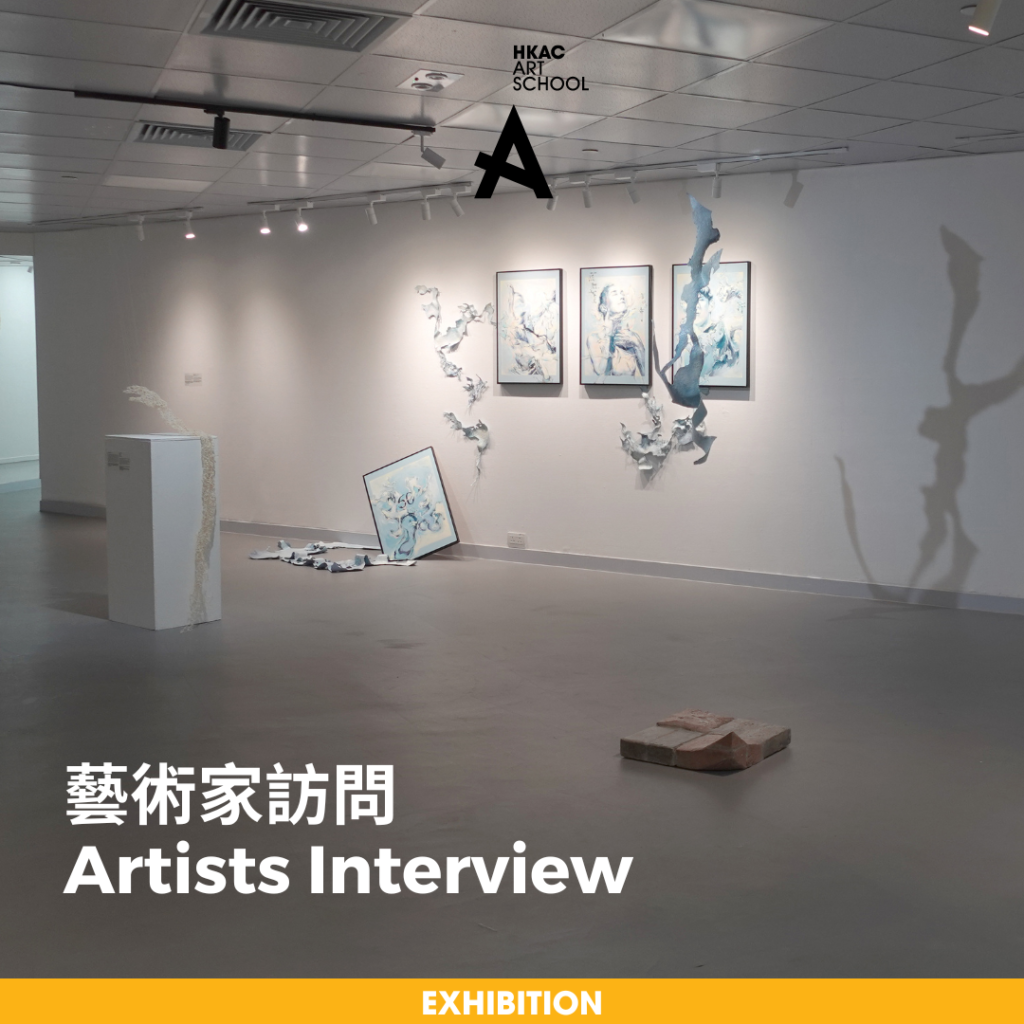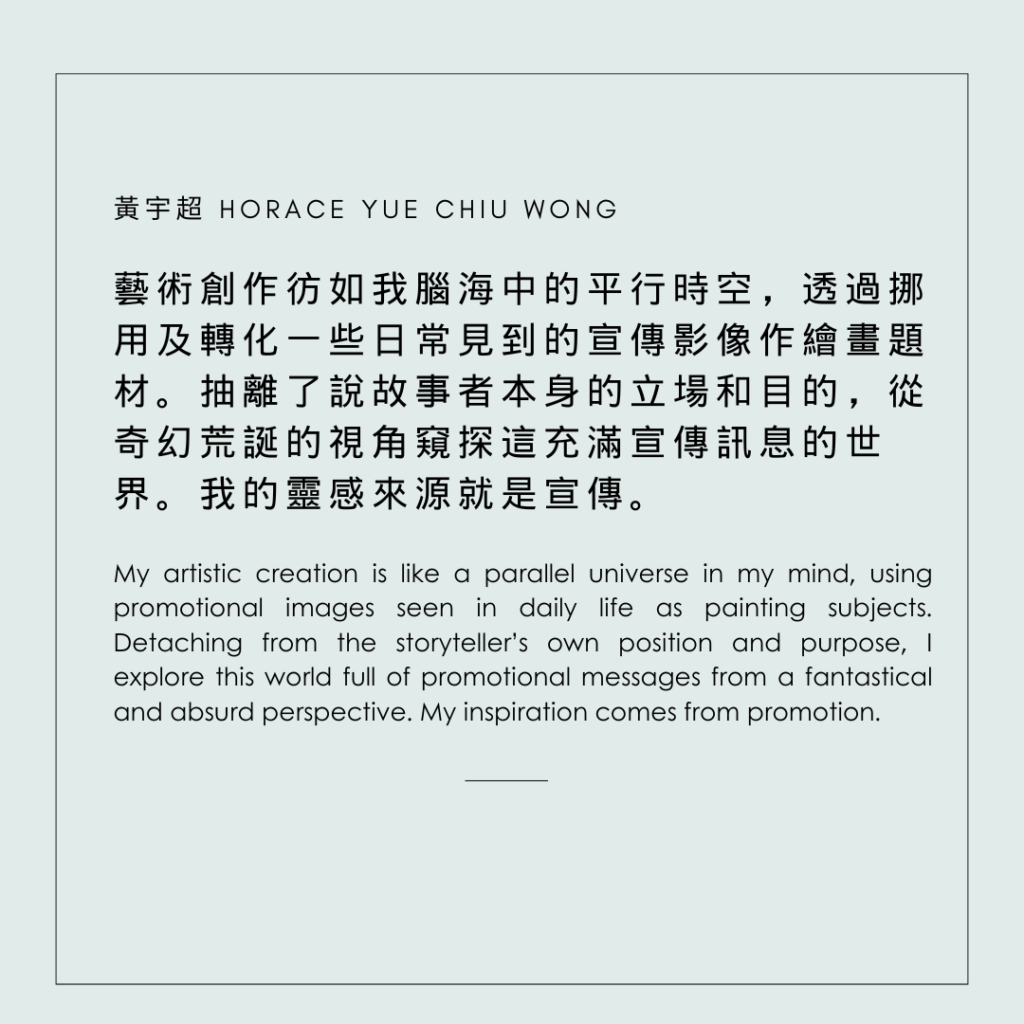
Published: 7/8/2024
A year after graduation, alumni of the Hong Kong Art School have reunited to present their latest exhibition, “Familiar Strangeness.” This exhibition is not only an artistic event, but also a profound reflection on everyday life. Five exhibiting artists: Wong Yu Chiu, Ng Ching Yee, Chan Tsz Yin, Wong Sze Chung, and So Yuk Heung, share their creative insights and artistic journeys.
“Familiar Strangeness” is the theme of this exhibition. With the artworks at the exhibition, Krizia aims to encourage the audience to re-examine the familiar aspects of daily life from a new perspective. She says, “Things we see every day, when presented in an alternative way, allow the audience to re-examine these familiar things.” By exploring lightbox advertisements, natural landscapes, urban environments, the human body, and changing matter, the exhibition rethinks the transformation and transition of these elements and explores the interaction between humans and their surroundings.
Returning to the Hong Kong Art School a year after graduation, from conception to the current exhibition, has brought a different experience for the five artists. Krizia deeply appreciates the challenges of planning an exhibition: “I deeply realize that putting on an exhibition is not just about creating the artwork but also considering the entire exhibition space and other related matters.” So emphasizes the importance of teamwork: “Since we don’t have a curator or a design company, everyone collaborates and is dedicated to taking on their roles.” Working together again was also an impactful experience, “In a way, it feels like our exhibition theme, “Familiar Strangeness,” Krizia describes. So recalls the good old days as a student: “It brought me back to the days of studying, setting up my works with Krizia and Christy in the sculpture room on Assessment Day.”
During the interview, they also shared their views on art. Krizia mentioned the impact of art on her life: “Art influences me to think about everything from multiple angles and has sparked my curiosity about different things. Since graduation, I haven’t done anything related to art. This year, I switched to a new job and spent a lot of time adapting to the new environment; coming back to participate in the exhibition feels a bit overwhelming. The biggest question raised was whether it is possible to pursue career advancement and continue to create and exhibit artworks simultaneously.”
Horace’s artistic inspiration mainly comes from his daily life: “My artistic creation is like a parallel universe in my mind, using promotional images seen in daily life as painting subjects.” As a brand and design worker, Horace creates images to tell stories for clients every day, ‘Detaching from the storyteller’s own position and purpose, I explore this world full of promotional messages from a fantastical and absurd perspective. My inspiration comes from promotion.’
Stephie’s work revolves around the relationship between nature and humans, responding to the unpredictable nature of life through the transformation of materials. “I tried to find a definition of humanity on Google Scholar, and this is the first article I found — ‘Humanity refers to the advanced psychological phenomena that humans possess and animals do not.’ Of course, we cannot define it based Solely on one scholar’s view, but to me, this sentence is interesting, as if summarizing the current way humans interact with nature. From history, we can see that anthropocentrism has divided humans and nature, creating a hierarchical classification. We place ourselves above all species, yet forget that we all originate from the same atom. We are no different from all the living and even non-living things around us; no one is nobler than the other. I value the creative process more, and what the audience sees in the exhibition is like an excerpt from my creative process. My relationship with the materials is one of co-creation. When it is exhibited, it forms a different connection with the viewers. The materials used this time are more sensitive to the surrounding environment, and the humidity and temperature in the space will cause different textural changes in the artwork. I hope that through the material’s own transformation process, the viewers can feel the vitality of the work and reshape our binary thinking about non-human species.”
Christy majored in sculpture during her studies and now works in the fashion industry. She alSo shares the subtle relationship between the two:“It is precisely because I work in the fashion-related field, that I have observed the differences and similarities between sculptural clothing and wearable art in fashion, such as structural three-dimensionality, cutting, shaping, and the arrangement of materials and fabrics. For the general public, runway fashion is seen as high-end fashion that is unattainable and extremely rare in everyday life. Therefore, it is interesting to incorporate the most common element—food—into sculpture. Creating wearable art with unconventional materials to emphasize or deconstruct body shapes has surfaced more than once in the current fashion world. My work comes from the details of everyday life, paying attention to shapes, textures and proportions, especially on clothing.”
“By narrowing or enhancing the size and volume, sculptural fashion presents distorted body shapes at specific moments or to a certain extent. From this, I learned how to handle wearable art and pay more attention to the relationship between the wearer and the clothing. I explored how sculpture creates a perSonal experience— an extension of the body, and explores and expresses fragile and transient materials. Occasionally, the boundary between fashion and wearable sculpture converges, and a dialogue between the work and the wearer emerges. It is very different from the ideal state of clothing presented by professional models at work; this piece is built around my intimate relationship. It changes the normal function of clothing and alSo modifies the body’s state and way of walking, imagining the attire of the people around. I hope to encourage deeper thinking and interpretation, below the surface of just seeing the covering of the body’s surface.”
So’s work often involves deconstructing and reconstructing items he finds, and he points out that the most important work is observing and analysing the structure of the items, then thinking about what changes he can make to them. “What does the change mean after all? For example, observing that the bricks on the ground are flat, flatness is their structure; then thinking about what I can do with this flat ground? Can it be uneven? If So, how is this unevenness presented?”
Looking back on their college days, the alumni also shared what they consider the most valuable, Krizia mentioned the precious experience she learned in art school: “As an adult student, the most valuable thing I learned in art school—Everything is possible. I’m Someone who fears losing; I won’t tell you that art school suddenly made me strong and fearless. But during these three years of learning in a space where the teachers are more persistent about your ideas or works than you are, you can’t back down. Although my current job is unrelated to art; the training from art school has indeed given me more confidence to accept challenges.” So mentioned the freedom in artistic practice: “There are few wrong things in artistic practice. So don’t be afraid of failure, try more.”
They also each gave their words of encouragement to young students aspiring to enter the art field:
Krizia: To the young and ambitious students: You are already invincible because you are young and ambitious; if you think that’s not enough, I’ll give you a line from American Artist Sol LeWitt’s letter to Eva Hesse: “Stop it and just. DO.” (1960 Sol LeWitt).
So: Keep it up!
Stephie: I am that young and ambitious student (laughs ^^). Just do your best in everything, don’t put too much pressure on yourself. Appreciate yourself more, praise yourself more. Being alive every day is already a great achievement.
This exhibition is not only an artistic event, but also a profound reflection on everyday life. Through the works of these artists and their words, we can see how art is intertwined with life, how it affects our way of thinking, and how it allows us to see the world around us with new eyes. The “Familiar Strangeness” exhibition is an opportunity to rediscover the beauty of the everyday, and is a reflection and review of our artists’ own journeys. These artists converse with us through their works, allowing us to feel the power of art through their diversity of mediums and ideas.

